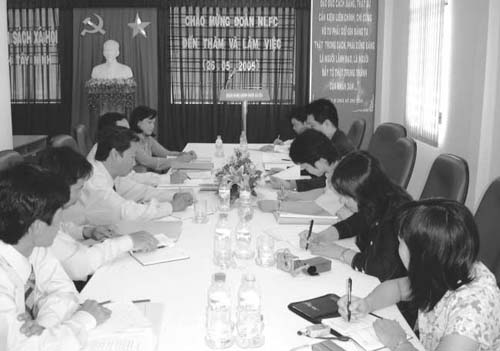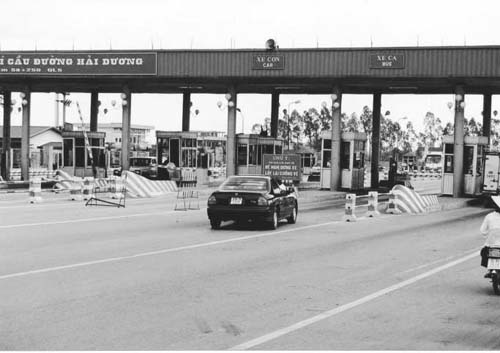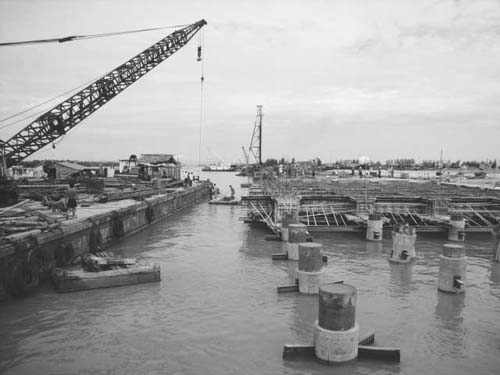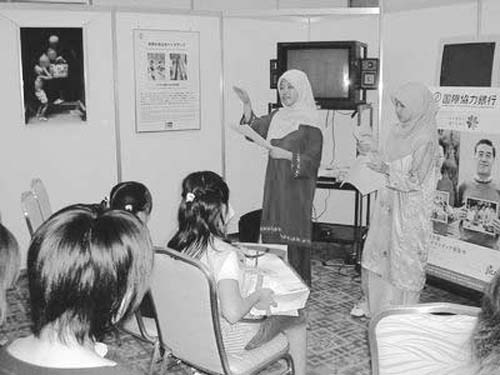Japan's Official Development Assistance White Paper 2006
Main Text > Part I JAPAN'S OFFICIAL DEVELOPMENT ASSISTANCE FOR WORLD PEACE AND PROSPERITY > Chapter 2 Specific Activities of Japan's ODA > Section 2. The Importance of Trade and Investment in Promoting Development and the Role of ODA
Section 2. The Importance of Trade and Investment in Promoting Development and the Role of ODA
Economic growth is essential in order to reduce poverty in developing countries and to improve people's living standards. The activities of private sector enterprises play an important role in achieving high economic growth rates. This is especially true in light of the globalization of the world economy in recent years. Trade—particularly export— and foreign direct investment play an increasingly large role in the economic growth of developing countries. By promoting exports and receiving foreign investment, developing countries can expand income and employment; and through transfers of technology and know-how of management they can strengthen the activities of their domestic private sector enterprises, and thereby provide the funds needed for development. The degree of dependence of developing countries on trade is high: exports account for 20-35% of their GDPs (with the exception of a few countries).6 In addition, the proportion of foreign direct investment in GDP in developing countries has increased remarkably, rising from 4% to 22% in the past 50 years.7
However, the conditions that exist in developing countries vary from country to country, and not all the countries enjoy the same benefits from trade and investment. The ability to achieve economic growth through export promotion is limited to those countries that have international competitiveness. In addition, foreign companies tend to make direct investment in those countries and regions which have established a good investment climate. These countries and regions usually have implemented appropriate macroeconomic policies; have abundant high-quality labor forces; have established legal systems for accepting investment and promoting trade; and the development of ports, roads, airports, and communications facilities along with systems for managing this infrastructure. Therefore, support for human resource development, the establishment of systems, and the development of infrastructure through ODA have great significance for countries that cannot create the environment necessary to promote trade and investment on their own capacity alone. For example, according to estimates by the World Bank, developing countries will need about US$233 billion for new infrastructure construction, including transportation, communications, and energy, between the years 2005 and 2010, along with US$232 billion to operate and maintain existing infrastructure. The expenses required for the construction, operation, and maintenance of infrastructure will account for more than 5% of the total GDP of developing countries.8 Acquiring such an enormous amount of funds is difficult for developing countries, and there are limits to what they can achieve on their own in the areas of human resource development and institution building.
Chart I-2 Total Net Resource Flows from DAC Countries and Multinational Agencies to Developing Countries

Japan's Support in Promotion of Trade and Investment: Example of East Asia
Up to now, Japan's ODA has actively provided comprehensive support in terms of infrastructure development, institution building, and human resource development aimed at promoting trade and investment. This policy is clearly stated in the ODA Charter and the new Medium-Term Policy on ODA (hereinafter the "Medium-Term Policy"), which forms the policy framework for ODA.
East Asia, including the Newly Industrializing Economies (NIEs), ASEAN, and China, is the region which has benefited the most from this Japanese assistance and has achieved particular progress in economic development and poverty reduction when compared with other regions of the world. In 1971, average per-capita GDP in this region was about US$266; by 2003, thanks to the remarkable economic growth, this average had risen to US$1,511.9 In addition, the population in absolute poverty, who live on less than one dollar a day, declined by 400 million between 1981 and 2003.
What has also played a role in poverty reduction through this growth is that an increase in direct investment received and trade resulting from economic stabilization and the development of a such an increasingly favorable environment for promoting trade and investment made possible by Japan's ODA. Japan has supported the self-help efforts of these countries through comprehensive assistance for economic growth such as infrastructure development, human resource development, and institution building in order to promote foreign direct investment to and export from East Asia. The total amount of Japan's ODA to East Asia between 1970 and 2004 amounted to approximately US$71.6 billion (in terms of net disbursement), which accounted for 54.4% of the total aid flow to this region provided by members of Organization for Economic Co-operation and Development--Development Assistance Committee (OECD-DAC).
Chart I-3 Trends in Japan's ODA by Sector (Commitment Basis)

Human resource development in developing countries is extremely important as a foundation to support economic growth. However, human resource development in developing countries is not associated solely with economic activities such as trade and investment; but also with a wider range of areas including education, health, sanitation, medical care and legal institutions. For example, the lack of educational opportunities is deeply interconnected with poverty. Human resource development can not be accomplished overnight, but requires many years of effort. Up to now, Japan has placed emphasis on supporting various levels of human resource development, from primary to higher education. In primary and secondary education, Japan has provided support for improving the quality of education by constructing schools, increasing enrollment, and developing the capacity of teachers, as well as by promoting communities' participation in school management. Japan has placed particular emphasis on science and mathematics education, which provides the basis for scientific and technological progress and the economic development of the recipient countries, and has provided support to 27 countries, including Asian countries such as ASEAN countries, Africa (especially Kenya), and Latin America (especially Honduras) to help them deal with economic globalization. Japan has provided technical assistance, particularly in the development of teaching materials and teacher training, to improve mathematics and science education, which is essential for technological and economic development. In addition, in order to address the internationalization of the universities in developing countries, Japan has provided support for building cross-border education and research networks and providing distance learning by using information technology. Examples include third country training for Southeast Asia centered in Thailand's King Mongkut's Institute of Technology Ladkrabang. At the University of the South Pacific (USP), which was established by 12 island nations in the South Pacific, distance learning is provided through the satellite intranet USP-Net between branch schools of the member countries located on geographically remote islands. Japan has also supported human resource development through the implementation of vocational training aimed at developing technical personnel to support their country's development.
Promoting foreign direct investment in and trade with developing countries requires macroeconomic stabilization and the establishment of institutions for trade and investment that conform to international rules. Japan has provided support for the formulation and implementation of economic policy and for creating institutions for promoting trade and investment. For example, in Mongolia and Viet Nam (to be discussed below), experts dispatched from JICA have provided advice concerning the policies to be introduced for shifting from state-planned economies to market economies.
This support for a transition to a market economy in Mongolia began with the preparation of a textbook concerning market economies in the Mongolian language. This textbook was based on lectures by a Japanese expert broadcast via television in 1990, which gave an easy-to-understand explanation of the market economy to general citizens. In 1991 a group for the promotion of a market economy in Mongolia was formed in Japan and provided macroeconomic support in public finance policy, foreign exchange policy, privatization, and the development of small and medium enterprises. The group also supported improving productivity, promoting exports, and establishing institutions for accepting foreign assistance. Japan also provided assistance to Cambodia, Viet Nam, and Laos for improvement of laws including civil law, commercial law, and civil proceedings law, to facilitate overseas trade and investment.
Assistance to developing countries also brings important economic benefits to Japan as well. That is, Japan's assistance through ODA to improve the trade and investment climate in East Asia promotes the activities of the local offices and plants of Japanese corporations operating overseas and expands the export markets as the economies of recipient countries grow. Japanese direct investment in East Asia increased sharply in the latter half of the 1980s as the investment climate was improved through ODA, rising from approximately ¥610.4 billion in FY198010 to ¥1,192.1 billion in FY1995. Although Japanese direct investment subsequently declined temporarily due to the Asian economic crisis in 1997 it later rebounded, and in FY2004 once again surpassed the 1,000 billion yen mark at ¥1,009.1 billion (in terms of investment accepted). Economic growth in the East Asia region has brought benefits to Japan's economy, as seen in steady growth in the local sales of the local subsidiaries of Japanese corporations. Imports of parts and supplies from Japan by these subsidiaries also increased to ¥7,871 billion in FY2004, which accounted for 35.4% of Japan's total exports.11
Chart I-4 Trends in East Asia's Trade Volume, Trade Volume Ratio to GDP, and Amount of Direct Investment Received

Japan's Contribution to the Improvement in Viet Nam's Investment Climate
The case of Viet Nam as an example of Japan's support for economic growth through ODA is explained below.
In 1986 the Socialist Republic of Viet Nam adopted the Doi Moi Policy, which aimed for liberalization of the country's economy while maintaining its socialist system. The country has continued its move toward the market economy since then. One concrete result of this measure has been membership in the ASEAN Free Trade Area (AFTA) in 1996.12
After restarting assistance to Viet Nam in 1992,13 Japan provided ODA in the amount of US$5,424.77 million (up to 2005) to Viet Nam. This assistance covered many areas, including infrastructure development, support for institutions and policies, and human resource development.
One typical example of support to Viet Nam in the area of institutions and policies is the development survey launched in 1995 to assist the country's move toward the market economy. The Vietnamese Government had decided to shift from a planned economy to a market economy and requested Japan to provide advice concerning specific policy measures. In response to this request, Japan performed a development survey between 1995 and 2001 headed by Mr. Shigeru Ishikawa, a professor emeritus at Hitotsubashi University, in cooperation with the concerned officials of the Vietnamese Government, prepared recommendations concerning various policy areas including public finance, industries and trade, agriculture and rural development, and reform of state-run companies (known as the Ishikawa Project). Japan used its own experience in economic reconstruction for this project.
In 2003, the Japanese and Vietnamese governments as well as Japanese companies cooperated closely to establish a Vietnam-Japan Joint Initiative to solve the problems faced by Japanese companies planning to invest in Viet Nam. Japan provided active support for Vietnamese self-efforts to improve the investment climate in the country and, in the end, 85% of the action plan was achieved. In response to this success, Phase 2 of this Initiative was launched to provide support for further institutional improvements in Viet Nam. During the three year period from the beginning of this initiative in 2003, foreign direct investment in Viet Nam increased from US$3.06 billion to US$6.02 billion. Furthermore, in order to support the promotion of the Comprehensive Poverty Reduction and Growth Strategy (CPRGS), Japan extended a yen loan worth ¥2,500 million to co-finance the World Bank's credit. Japan also provided support to the Vietnam Bank for Social Policies for improving know-how in small-scale finance and for reform of the tax system scheduled for implementation in 2010. Japan thus actively supports the institutional infrastructure building in Viet Nam.

A scene of a local study at the Vietnam Bank for Social Policies (Photo: the Ministry of Finance)
In addition to assistance in policy formulation, Japan also contributed significantly to the development of infrastructure for promoting economic activities. An example was the construction of transportation infrastructure in the northern region that began in 1994. Up to that time, direct investment had been concentrated in the southeastern region, particularly Ho Chi Minh City, since the enactment of the Doi Moi Policy. In order to encourage direct investment by improving the investment climate in Viet Nam's northern region and to stimulate the economy of this region, Japan implemented restoration work on Hai Phong Port, which boasts the highest freight forwarding volume in the northern region, and improvement work on National Highway No. 5, which links Hai Phong Port to the capital Hanoi.

Improvement work on National Highway No. 5 (Viet Nam) (Photo: JBIC)
Chart I-5 National Highway No.5 and Hai Phong Port in Northern Viet Nam

At that time, investment from foreign companies in Viet Nam was vigorous, particularly in the northern region, where Japanese corporations formed mergers in joint ventures with local companies to construct industrial parks, and companies of foreign capital and local companies began to set up operations there, thereby stimulating the economy. In the Thang Long Industrial Park about 60 companies, mainly Japanese ones, occupied the Park. According to the developer company that is developing, selling and managing the Thang Long Industrial Park, foreign direct investment in the Park as a whole amounted to US$1.1 billion as of March 2006. The company also reports that all of the products of this industrial park were manufactured for export, and the total amount of exports was US$730 million, or 2.2% of Viet Nam's total exports. As a result of the restoration projects for National Highway No. 5 and Hai Phong Port, the industrial production growth rate rapidly grew from 8.2% in 1999 to 24.8% in 2002 in Hanoi, and from 17.6% in 1999 to 24.9% in 2002 in Hai Phong.14
Box I-1. Outline of the Development Initiative for Trade

Rehabilitation plan for Haiphong Harbor (Viet Nam)
Future Initiatives
To achieve development through trade and investment, it is extremely important to promote free trade under the WTO system. The WTO Doha Round was initiated in the WTO Ministerial Conference held in Doha, Qatar in 2001. The Doha Round negotiations were officially called the Doha Development Agenda negotiations and emphasized the development of developing countries through participation in the multilateral trading system.
Success in the current round, which focuses on economic growth and poverty reduction through trade, will have great importance for developing countries. The success of the current round, which aims for further promotion of the free trading system, including developing countries, will be also highly significant for Japan, whose economic activities depend on trade. However, since the differences in the views of the WTO members have not been bridged, the Doha Round negotiations were suspended at the end of July 2006. For Japan, which has contributed actively with a view to realizing the early conclusion of the Round so as to strengthen free trade under the WTO system, this suspension of negotiations represented a major blow, as it did for developing countries, especially the Least Developed Countries (LDCs) (see Part II, Chapter 2, Section 2 for the current status of the Doha Round negotiations).
Prior to the "WTO Hong Kong Ministerial Conference" held in December 2005, Japan announced the "Development Initiative for Trade" for the purpose of promoting a free trading system that included developing countries. Considering the fact that developing countries now account for three quarters of the 149 WTO member countries, Japan intends to provide under this Initiative comprehensive support through a wide range of measures such as financial and technical assistance including that for infrastructure development, under the headings of "Produce," "Sell," and "Buy." This is to enable developing countries to fully benefit from trade and to allow especially those with low competitiveness to further strengthen self-reliance in accordance with the state of economic development. In this initiative, Japan also expressed its intention to provide Duty-Free and Quota-Free market access for essentially all products originated from LDCs, and is currently making preparations in order to implement the treatment in FY2007.
The "Development Initiative for Trade" has been praised highly by various countries. For example, in the "Symposium on the Doha Development Agenda: toward Effective Implementation of Japan's New Development Initiative for Trade and Japan's Cooperation for Africa" held in Tokyo on March 14, 2006, the ambassadors of Kenya and Benin praised it as a practical initiative which is expected to contribute to the software aspects, namely, the development of human capacities. On a visit to Japan, President Bingu wa Mutharika of Malawi expressed his appreciation to the then Prime Minister Junichiro Koizumi for technical assistance to the "One Village One Product" movement in Malawi under this Initiative. Furthermore, when the then Prime Minister Koizumi visited Africa in May, African leaders expressed their appreciation for Japan's overall support for Africa, including the Development Initiative for Trade.
In addition, the United Nations' sponsored symposium for introducing Japan's efforts was organized at the UN Headquarters, and Japan's Development Initiative for Trade was highly praised among delegates of member countries. Mr. Anwarul K. Chowdhury, UN Undersecretary General and High representative for the LDCs, who organized this symposium, expressed in a newspaper article his high appreciation of Japan's efforts including the Development Initiative for Trade, writing that such efforts are favorable to developing countries in a true sense.
Japan is also taking active steps toward concluding EPAs15 with other countries, including developing countries, with a view to complementing and strengthening the WTO system. Concluding EPAs with developing countries, whose stage of development differs from that of Japan, requires Japan to provide active assistance to develop human resources and improve the economic institutions in the countries signing the agreement. This assistance includes support for human resource development, improvement of investment climate, such as establishing domestic legal systems covering protection of intellectual property right and competition policy, and also support for ICT, science and technology, and small and medium enterprises.
In addition to dealing with matters associated with trade in goods, such as the removal of tariffs and quotas, EPAs also call for efforts to strengthen economic relations between the countries signing the agreement and include cooperation for that purpose; that is, measures to facilitate economic transactions between these countries and to harmonize economic institutions. Thus, for countries which have not established the infrastructure and legal systems that serve as the foundation for facilitating economic transactions and harmonizing economic institutions, it is important that ODA be used as an effective tool to build these institutions and to further enhance the economic effects of EPAs.
For developing countries, concluding EPAs will stimulate trade with countries signing the agreement and promote economic growth. EPAs bring benefits to both developed and developing countries through trade. In particular, EPAs will constitute a framework which strengthens human resource development and economic institutions in developing countries.
For instance, Japan decided to support Malaysia which concluded the EPA in December 2005 in seven areas for cooperation, including agriculture, forestry and fisheries, education and human resource development, ICT, and small and medium enterprises, so as to develop the capabilities of trade and investment in Malaysia. Japan has put 24 cooperation projects on fast track, including the Higher Education Loan Fund Project (HELP III) and Capacity Development for the SME Development Corporation and has been supporting human resource development and institution building in Malaysia through its ODA.

A scene of an event participated in by students who came to Japan under the Higher Education Loan Fund Project (HELP III) (Photo: JBIC)
Based on the experience of economic growth in East Asia, Japan, which places emphasis on economic growth through the stimulation of trade and investment, will continue to actively assist the efforts of developing countries.


 Next Page
Next Page